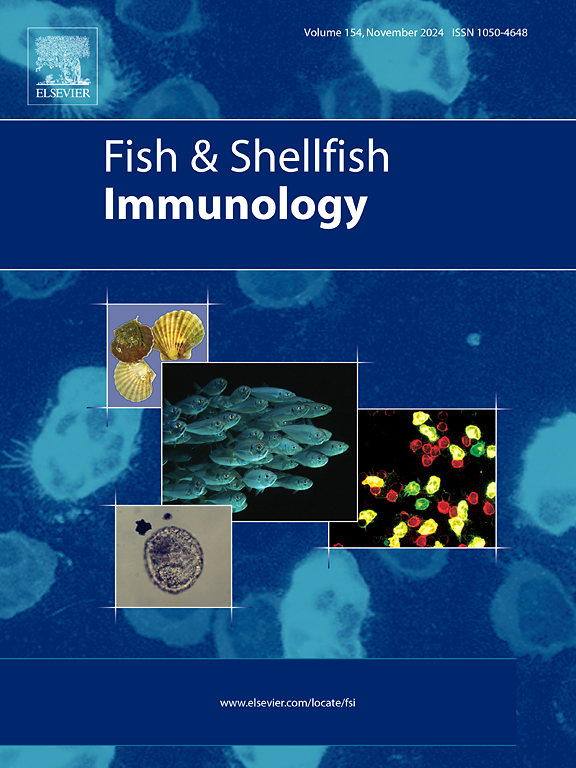Marine macroalgae Chaetomorpha aerea as a dietary supplement: Optimizing immunity and resistance to Edwardsiella tarda in tilapia (Oreochromis mossambicus)
IF 3.9
2区 农林科学
Q1 FISHERIES
引用次数: 0
Abstract
The intensification of aquaculture has led to a rise in fish infections, necessitating the search for alternative antibiotics. In this context, our study investigated the effects of dietary supplementation with Chaetomorpha aerea, a filamentous green algae, on the immune health and resistance to infections in tilapia (Oreochromis mossambicus). Diets containing varying concentrations of C. aerea (0, 1, 2, 5, and 10 g/kg) were prepared and administered to the fish for 30 days, followed by a challenge with Edwardsiella tarda to evaluate survival rates. The results were significant. The diet containing 5 g/kg of C. aerea (group T3) brought about substantial improvements in hematological parameters, including increases in red blood cell count (RBC), hematocrit (Hct), and hemoglobin (Hb). The T3 group exhibited a robust immune response, with higher lysozyme and ceruloplasmin activity in immunological assays. LBP gene expression was significantly elevated in the spleen and thymus of fish in the T3 group, which correlated with higher survival after bacterial challenge compared to the control group. Principal Component Analysis (PCA) and cluster analysis confirmed that the 5 g/kg concentration stood out for maximizing immunological benefits without compromising the overall health of the fish. These findings highlight the robust immune response in the T3 group, a key finding of our study. We conclude that supplementation with C. aerea represents a promising and sustainable alternative in the formulation of diets for tilapia, contributing to improved health and resistance to diseases. Future studies are recommended to explore its application in other species and development stages, in addition to evaluating other health biomarkers.
海洋大型藻类 Chaetomorpha aerea 作为膳食补充剂:优化铁甲鱼(Oreochromis mossambicus)对Edwardsiella tarda的免疫力和抵抗力。
水产养殖的加强导致鱼类感染率上升,因此有必要寻找替代抗生素。在此背景下,我们的研究调查了饵料中添加丝状绿藻Chaetomorpha aerea对罗非鱼(Oreochromis mossambicus)免疫健康和抗感染能力的影响。制备含有不同浓度(0、1、2、5 和 10 克/千克)Chaetomorpha aerea 的饵料,并给鱼喂食 30 天,然后用 Edwardsiella tarda 进行挑战,以评估存活率。结果很明显。每公斤含 5 克 C. aerea 的饲料(T3 组)大大改善了血液参数,包括红细胞计数(RBC)、血细胞比容(Hct)和血红蛋白(Hb)的增加。T3 组表现出强有力的免疫反应,在免疫测定中溶菌酶和脑磷脂酶活性较高。与对照组相比,T3 组鱼类脾脏和胸腺中的枸杞多糖基因表达明显升高,这与细菌挑战后存活率较高有关。主成分分析(PCA)和聚类分析证实,5 克/千克的浓度能在不损害鱼类整体健康的情况下最大限度地提高免疫效益。这些发现凸显了 T3 组的强健免疫反应,这也是我们研究的一个重要发现。我们的结论是,在罗非鱼的日粮配方中补充 C. aerea 是一种有前景且可持续的替代品,有助于改善健康状况和提高抗病能力。建议今后开展研究,除了评估其他健康生物标志物外,还探索其在其他物种和发展阶段的应用。
本文章由计算机程序翻译,如有差异,请以英文原文为准。
求助全文
约1分钟内获得全文
求助全文
来源期刊

Fish & shellfish immunology
农林科学-海洋与淡水生物学
CiteScore
7.50
自引率
19.10%
发文量
750
审稿时长
68 days
期刊介绍:
Fish and Shellfish Immunology rapidly publishes high-quality, peer-refereed contributions in the expanding fields of fish and shellfish immunology. It presents studies on the basic mechanisms of both the specific and non-specific defense systems, the cells, tissues, and humoral factors involved, their dependence on environmental and intrinsic factors, response to pathogens, response to vaccination, and applied studies on the development of specific vaccines for use in the aquaculture industry.
 求助内容:
求助内容: 应助结果提醒方式:
应助结果提醒方式:


